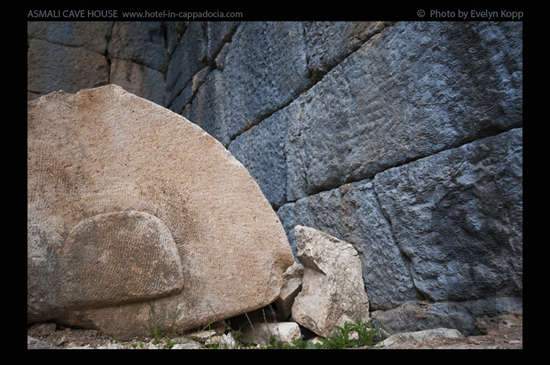Letoon an der Lykischen Küste - Türkei...

DIE LYKISCHE KÜSTE - DIE ANTIKE STADT LETOON
The ruins of Letoon are situated in the village of Bozoluk.
They can be reached by driving along a four-kilometer road that exits off the Kaş - Fethiye Road before Kınık.
Mythologie: The Goddess Leto
Leto is said to have been always mild, gentlest among the Olympians, and kind to both mortals and immortals, for she is believed to grant whatever is asked of her.
Although she is not Zeus' wife, she may be seen playing the lyre with him in the midst of the gods.
When Hera learned about Zeus' and Leto's love affair, she decreed that Leto should give birth at a place where the sun did not shine.
At the same time, Python, the dragon that gave oracular responses and was fated to be killed by Leto's son, started to follow her in order to kill her.
So Zeus let the North Wind carry her away, and the wind bore her to Poseidon, who protected her without violating Hera's decree, by taking her to the island of Ortygia,
which he covered with waves. That is why Python could not find her; and when this dragon had returned to Mount Parnassus, Poseidon brought the island to the surface of the sea.
Zeus consorted with Leto before he married Hera, and because of their love affair, Leto was hunted over the whole earth by the jealousy of Hera, not being able to
find a place where she could deliver her twins.
In her wanderings, Leto came from Crete to the western coast of Asia Minor, to Islands and Mountains, to Ephesus and Cos, to Cnidos, Naxos, Paros, and many other lands,
looking for a place to give birth.
Having wandered through many countries, Leto came to the rocky island of Delos and there she gave birth to her twins.
On her arrival, Leto cast her arms around an olive tree, and kneeling on the meadow, gave birth first to Artemis,
and then with the help of this goddess' midwifery, to Apollo.
Her troubles did not stop after giving birth; for Leto, having arrived with her newborns to a certain place in Lycia, in Asia Minor, where there was a lake,
For her it was forbidden by the inhospitable locals to quench her thirst.
No matter how much she begged them to let her drink, they would still forbid her to touch the water; and as Leto insisted, the Lycian peasants threatened her, and soiled the pool with their feet and hands, stirring up the mud from the bottom.
And seeing them so tight-fisted and mean, and at the same time so in love with the pool, Leto turned them into frogs so that they could live in its depth for ever, enjoying the water and the mud.
Among the first things the twin gods Apollo and Artemis did so soon they were born, was to punish all the men of that time, who refused to receive the pregnant
wanderer Leto when she came to their land. Some say that only four days after his birth, Apollo went to Mount Parnassus and killed the dragon Python, thus avenging his mother.
Among the mortals there was a woman named Niobe. She was a jealous woman, and had given birth to six daughters and six sons. When she heard people praying to Leto,
praising her for her children and her own self, Niobe cried out "Why do you praise the dark robed one? Praise me! For where she has only two children, I have twelve."
Leto, the mildest of the gods, the kindest, would probably have done nothing. But Leto's children were Olympians and would allow no such slander of their mother.
Apollo, with his fiery golden arrows, shot down each of the six sons and they died in unequalled pain. Artemis, with her painless silver arrows, likewise murdered each of the daughters. Niobe wept with misery to see all of her beautiful children slaughtered in the prime of life. But Artemis and Apollo left her two - the same number as themselves. He says they spared both the youngest girl and the youngest boy. Their names were Amphion and Chloris, and though their mother still wept, at least she had them.
During the Trojan War, Leto sided, as her children, with the Trojans, and she, together with her daughter healed the wounded Aeneas in a sanctuary,
while Apollo fashioned a wraith in his likeness to delude the warriors in the battlefield.
A Greek legend is that the river was created by the birth pangs of Leto, whose temple, at the Letoon, is on the west bank of the river a few kilometers south of Xanthos.

Das kleine, aber aussergewöhnliches Höhlenhotel bietet luxuriöse Suiten in einem historischen Höhlenhaus in Kappadokien. Umgeben von der Schönheit der Natur ist es ideal für Reisende, die einen individuellen Urlaub suchen, Liebhaber der Fotografie und Familien, die etwas besonderes erleben möchten.
.
.
Schroffe Felsen und die Farben des Meeres der Lykischen Küste, die
atemberaubenden Landschaften von den Höhen der Ausläufer des nahe
gelegenen Taurus Gebirges, aber auch versteckte Wasserläufe und eine
reiche Vegetation dieser Region bilden wunderbare Motive und sind nicht
selten eine Herausforderung für den Amateur- aber auch den
Profi-Fotografen.
Unzählige Motive Antiker Städte im Detail warten darauf von Ihnen
entdeckt und einmal in ganz anderem Licht gezeigt zu werden.
Vergängliches
fotografisch festgehalten
Impressionen nur noch selten gesehenen
Handwerks und Architektur der Lykischen Küste und des nahen Taurus
Gebirges, verlassen und marode der Vergänglichkeit überlassen
Ein Einblick in Traditionen und Details, in die Kristall-Kugel und Nachtaufnahmen








